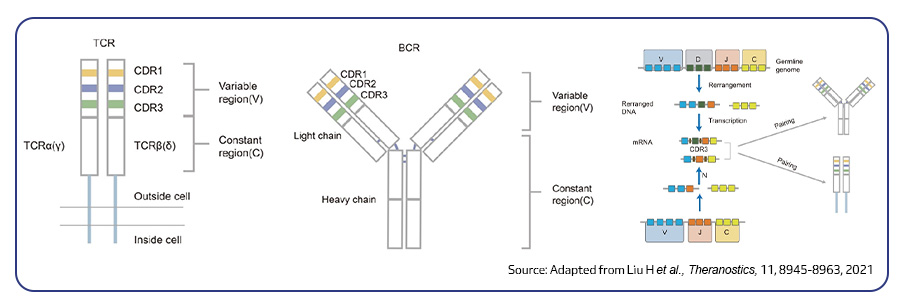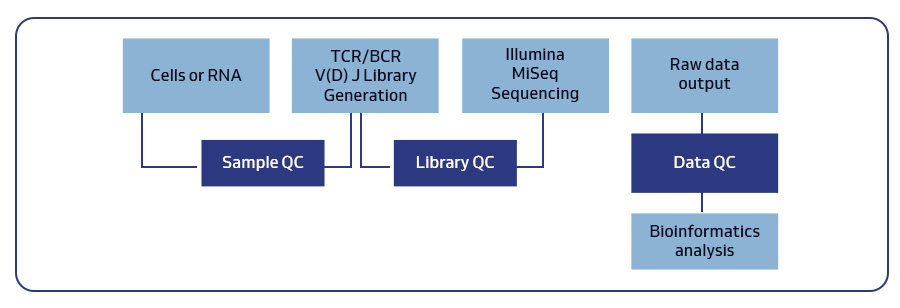By Dr. Lavanya Balakrishnan and Vinay C. G., MedGenome Scientific Affairs
The adaptive immune system’s ability to recognize and neutralize a vast array of pathogens relies on the diversity of its lymphocyte repertoire. T and B lymphocytes, with their unique T cell receptors (TCRs) and B cell receptors (BCRs), are crucial for immunological memory and effective immune responses. This diversity allows the immune system to identify and combat a broad range of pathogens. Studying immune repertoire diversity offers valuable insights into disease mechanisms, therapeutic strategies, and vaccine development.
How TCRs and BCRs differ and contribute to immune repertoire diversity
TCRs recognize antigenic peptides presented by MHC molecules, while BCRs and antibodies bind directly to antigen surfaces. TCRs consist of either α and β chains or γ and δ chains, with most T cells expressing αβ TCRs and a smaller percentage expressing γδ TCRs involved in innate immunity. BCRs are membrane-bound and consist of heavy and light chains, while immunoglobulins (Ig) are secreted by B/plasma cells1,2.
These immune receptors arise from somatic V(D)J recombination, generating over 1018 potential diversities in T cells and 1013 in B cells. Each receptor is composed of variable (V), diversity (D), joining (J), and constant (C) gene segments, which determine lymphocyte specificity. TCRs and BCRs include three complementarity-determining regions (CDR1, CDR2, CDR3), with CDR3 being crucial for antigen binding. Recombination involves joining D and J segments first, then V, with exonucleases removing and random nucleotides being added, enhancing junctional diversity. The D segment is present only in TCR β, TCR γ, and BCR heavy chains, while other chains only involve V and J segments. B cell receptors may also undergo somatic hypermutation and class-switch recombination to enhance antibody affinity and diversify the immune repertoire1,2.

Leveraging immune repertoire sequencing for innovative therapeutic strategies
Immune repertoire profiling, through TCR and BCR sequencing, provides a comprehensive view of the immune system. By analyzing clonal diversity and dynamics, researchers gain insights into immune responses, disease mechanisms, and therapeutic targets. This approach is transforming our understanding of immunity and driving advancements in immunotherapy, immuno-oncology, autoimmune, and infectious diseases. Several studies have validated the utility of immune repertoire sequencing for investigating fundamental questions in healthcare and medical science. Summarized below are a few studies that highlight the benefits of bulk TCR/BCR sequencing in advancing our understanding of immune responses.
Overlapping T cell signatures in blood and tumor correlate with PD-1 efficacy
T cell receptor repertoire predicts response to PD-1 immunotherapy. Given the increasing use of PD-1 blockade, identifying predictive biomarkers is crucial. TCR repertoire analysis of gastrointestinal cancer cases who have undergone treatment with anti-PD1 antibody (nivolumab) revealed a correlation between treatment response and the overlap of T cell clones found in blood and tumor tissue. Individuals with a higher frequency of shared T cell clones in their blood before treatment experienced better clinical outcomes. These findings suggest that TCR repertoire analysis can potentially serve as a predictive biomarker to guide stratification of individuals for PD-1 therapy3.
Characterization of TCR and BCR repertoires in hepatocellular carcinoma
In hepatocellular carcinoma (HCC), tumor-infiltrating T and B cells play a crucial role in anti-tumor immunity. Analyzing immune repertoire (IR) features of tumor and non-tumor tissues from 64 HCC cases revealed high IR heterogeneity, with non-tumor tissues showing higher BCR diversity and somatic hypermutation, while tumor tissues had comparable or higher TCR diversity and lower immune infiltration. Notably, higher IR evenness in tumors and lower TCR richness in non-tumor tissues correlated with better patient survival. These findings suggest that IR features could serve as biomarkers for HCC diagnosis and treatment, aiding future immunotherapy strategies4.
COVID-19 severity linked to T and B Cell receptor profiles
By comprehensively profiling the immune responses of individuals infected with SARS-CoV-2, researchers constructed a vast repository of B and T cell receptor sequences. Analysis of this data revealed distinct patterns in antibody and T cell responses correlated with disease severity and progression. Specific B cell clusters associated with virus-neutralizing antibodies were identified, along with diverse T cell responses involved in early immune activation, antiviral responses, and regulatory functions. These findings provide a foundation for developing effective vaccines and immunotherapies against SARS-CoV-25.
Decode immune repertoires with MedGenome’s immune profiling solutions
MedGenome delivers advanced immune profiling solutions to unravel the intricacies of TCR and BCR repertoires. Our comprehensive platform integrates high-throughput technology with expert bioinformatics, providing precise and actionable insights. From sample preparation to in-depth repertoire characterization, including the detection of rare clonotypes, our seamless workflow empowers researchers to accelerate discoveries. Our expert team offers tailored support and generates publication-ready results. Utilizing Takara’s Immuneprofiler and VDJ tools, our analysis pipeline delivers comprehensive reports encompassing full-length clonotype sequences, clonal frequencies, diversity metrics, V and J gene usage, and phylogenetic analysis of targeted clonotypes.

| TCR | BCR | |
|---|---|---|
| Sample type | Cells, tissue, blood and purified RNA | Cells and purified RNA |
| Sample requirement | >10ng Total RNA; >50 cells | 10ng-3μg RNA; 1000-10,000 cells |
| Library generation method | Takara SMARTer TCR alpha/beta Profiling Kit (Human, Mouse and custom species) | Takara SMARTer BCR IgG/M Profiling Kit (Human and Mouse) |
| Analysis offerings | Standard Analysis
| Standard Analysis
|
MedGenome’s comprehensive and precise immune repertoire analyses enables the identification of critical biomarkers and therapeutic targets, empowering researchers to develop innovative treatments for cancer, infectious diseases, and autoimmune disorders.
Optimize your immune research with MedGenome’s advanced repertoire profiling. Contact us to see how our immune profiling and antibody discovery services can accelerate your R&D efforts.
References
-
- Liu H, Pan W, Tang C, Tang Y, Wu H, et al. The methods and advances of adaptive immune receptors repertoire sequencing. Theranostics. 11, 8945-8963 (2021).
- Katoh H, Komura D, Furuya G, Ishikawa S. Immune repertoire profiling for disease pathobiology. Pathol Int. 73, 1-11 (2023).
- Aoki H, Ueha S, Nakamura Y, Shichino S, Nakajima H, et al. Greater extent of blood-tumor TCR repertoire overlap is associated with favorable clinical responses to PD-1 blockade. Cancer Sci. 112, 2993-3004 (2021).
- Xie S, Yan R, Zheng A, Shi M, Tang L, et al. T cell receptor and B cell receptor exhibit unique signatures in tumor and adjacent non-tumor tissues of hepatocellular carcinoma. Front Immunol. 14, 1161417 (2023).
- Schultheiß C, Paschold L, Simnica D, Mohme M, Willscher E, et al. Next-Generation Sequencing of T and B Cell Receptor Repertoires from COVID-19 Patients Showed Signatures Associated with Severity of Disease. Immunity. 53, 442-455.e4 (2020).
#Immune repertoire sequencing, #T-cell receptor, #B-cell receptor, #TCR, #BCR, #Adaptive immune system, #V(D)J recombination, #Somatic hypermutation, #Class switch recombination, #Immunotherapy, #COVID-19, #Biomarkers, #Immuno-oncology, #Autoimmune diseases, #Antibody discovery
 US
US IN
IN

